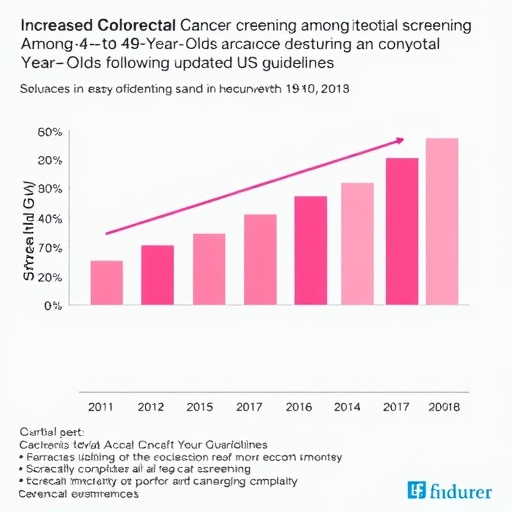A recent cohort study published in JAMA Network Open reveals a striking surge in colorectal cancer screening rates among younger adults, specifically those aged 45 to 49, following the U.S. Preventive Services Task Force’s (USPSTF) guideline revision. This adjustment marks a pivotal shift in public health strategy, extending routine colorectal cancer screening recommendations to a younger demographic. The data indicate that facility-based screening in this age group increased nearly tenfold, signifying rapid adoption and integration of these updated guidelines into clinical practice.
The USPSTF’s decision to lower the screening age was motivated by an alarming rise in colorectal cancer incidence among younger adults, a trend that has confounded oncologists and epidemiologists alike. Prior to this change, routine screenings were primarily recommended for adults beginning at age 50. With the guideline amendment, medical facilities swiftly incorporated enhanced screening protocols targeting the 45 to 49 age group, catalyzing a substantial shift in preventive healthcare dynamics. This transition underscores physicians’ responsiveness to emerging evidence and patients’ increasing awareness and willingness to undergo early screening.
Advanced colorectal cancer screening methods, such as colonoscopy and fecal immunochemical testing (FIT), are crucial for early detection and intervention, markedly improving patient outcomes. The study showcased how integrating such screenings in younger adults could potentially reduce mortality rates by identifying precancerous lesions before they progress. Clinicians have been encouraged by the rapid uptake, which reflects both provider endorsement and patient compliance, foundational factors for effective population health management.
The data emerge from a comprehensive cohort analysis, which meticulously tracked screening behaviors at healthcare facilities, enabling precise measurement of uptake trends. Researchers observed that while screening rates increased modestly among adults aged 50 to 75 during the same period, the escalated growth rate in those aged 45 to 49 was distinctly pronounced. This disparity highlights a targeted shift in clinical operations, emphasizing the critical role of guideline dissemination and adoption within healthcare institutions.
One pivotal aspect of this study is the implication it holds for healthcare systems and policy planners. The rapid integration of the new USPSTF recommendations challenges the inertia often associated with clinical guideline implementation. It suggests that with appropriate communication and institutional support, facilities can adjust screening practices swiftly to accommodate evolving epidemiological evidence. This responsiveness could serve as a model for future preventive health initiatives across various medical fields.
From a technical standpoint, the surge in screening among younger adults necessitates an evaluation of resource allocation within healthcare infrastructures. Increased demand for endoscopic services and associated diagnostic procedures requires careful planning to avoid bottlenecks that might delay screenings or affect care quality. Health systems must balance accessibility, cost, and capacity to ensure that the benefits of early detection are fully realized without overstraining clinical resources.
Moreover, this study prompts further investigation into patient demographics and socio-economic factors influencing screening uptake. Understanding the barriers and facilitators for younger adults participating in colorectal cancer screening can inform targeted awareness campaigns and outreach efforts. Early data suggest that patient education and physician recommendation play pivotal roles in motivating this population to engage in preventive care.
An intriguing dimension of the study involves analyzing the impact of evolving screening technologies and protocols on adherence rates. Enhanced accuracy and non-invasive testing modalities might contribute to increased acceptance of early screening, reducing the reluctance associated with traditional invasive procedures. These technological advancements, paired with guideline updates, create an environment conducive to shifting public attitudes and healthcare behaviors.
As colorectal cancer continues to pose a significant public health challenge, particularly with rising incidence among younger adults, the findings of this research underscore the potential for early intervention to mitigate disease burden. The nearly tenfold increase in screening serves as a beacon of hope, reflecting concerted efforts between guideline bodies, healthcare providers, and patients. It also establishes groundwork for longitudinal studies assessing long-term outcomes of this demographic shift.
Importantly, the study’s findings are tempered by the need for ongoing surveillance to monitor screening efficacy, follow-up adherence, and resultant cancer incidence and mortality trends. Future research should address these facets to comprehensively assess the public health impact of expanded screening guidelines. Such evidence will be critical in fine-tuning recommendations and ensuring they remain aligned with epidemiological realities.
In conclusion, this landmark cohort study offers compelling evidence that changes in clinical guidelines, when effectively disseminated and implemented, can rapidly transform healthcare practices and potentially improve cancer prevention outcomes among younger populations. The rapid uptake of colorectal cancer screening in adults aged 45 to 49 epitomizes successful integration of scientific research into everyday clinical care. As the medical community continues to grapple with the shifting landscape of cancer epidemiology, these insights provide a roadmap for agile, evidence-based preventive strategies.
For medical professionals and public health stakeholders, this research highlights the necessity of proactive engagement with evolving guidelines and patient education. As colorectal cancer screening expands to younger adults, a collaborative approach will be essential to optimize early detection, reduce disease burden, and ultimately save lives.
Subject of Research: Facility-based colorectal cancer screening uptake following USPSTF guideline changes in adults aged 45 to 49.
Article Title: (Not specified in the provided content)
News Publication Date: (Not specified in the provided content)
Web References: (Not provided)
References: DOI: 10.1001/jamanetworkopen.2025.41330
Image Credits: (Not provided)
Keywords: Colorectal cancer, Cancer screening, Preventive healthcare, USPSTF guidelines, Epidemiology




